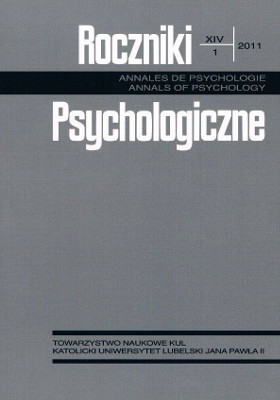Niepokój jako korelat poczucia osamotnienia u homoseksualnych mężczyzn
Abstract
The present study focuses on the relationship between sense of loneliness and level and structure of anxiety in homosexual men. Seventy-two homosexual men, aged from 18 to 41, took part in the study and were investigated with the IPAT Scale and De Jong-Gierveld’s Loneliness Scale. The sexual orientation of each participant was determined by his direct declaration. The results of this study show that anxiety correlated with the level of loneliness and accounted for approximately 28% of variance in loneliness among homosexual men.
References
Buss, A. H. (1980). Self-consciousness and social anxiety. San Francisco: Freeman.
Carson, R., Butcher, J., Mineka, S. (2003). Psychologia zaburzeń. Gdańsk: GWP.
Cattell, R. B., Scheier, I. H. (1967). Handbook the IPAT Anxiety Scale Questionnaire. Champaign, Il. Institute for Personality and Ability Testing.
CBOS (1988). Opinie o homoseksualizmie. Tolerancja czy potępienie? Komunikat z badań. BDF/411.
Chipuer, H., Bramston, P., Pretty, G. (2003). Determinants of subjective quality of life among rural adolescents: A developmental perspective. Social Indicators Research, 61,1, 79.
Curtona, C. E. (1982). Transition to college: Loneliness and the process of social adjustment. W: A. Peplau, D. Perlman (red.), Loneliness: A source book of current theory, research and therapy (s. 291-309). New York: Interscience.
Diamont, L., Windholz, G. (1981). Loneliness in college students: Some theoretical, empirical, and therapeutic considerations. Journal of College Students Personel, 22, 515-522.
Edwards, R., Bello, R., Brandau-Brown, F., Hollems, D. (2001). The effects of loneliness and verbal aggressiveness on message interpretation. The Southern Communication Journal, 66, 2, 139-150.
Gagnon, J. H., Simon, W. (1973). Sexual conduct: The social sources of human sexuality. Chicago: Aldine Books.
Hansson, R. O., Jones, W. H., Carpenter, B. N., Remondet, I. (1986). Loneliness and adjustment to old age. International Journal of Aging and Human Development, 24, 41-53.
Imieliński, K. (1982). Zarys seksuologii i seksiatrii. Warszawa: PZWL.
Imieliński, K., Dulko, S. (1988). Przekleństwo androgyne. Transseksualizm: mity i rzeczywistość. Warszawa–Kraków: PWN–ARC-EN-CIEL.
Iniewicz, G. (2009a). Specyfika relacji w parach homoseksualnych. Psychiatria Polska, 43, 1, 77-86.
Iniewicz, G. (2009b). Społeczno-kulturowy kontekst terapii osób o homoseksualnej orientacji. Psychiatria Polska, 43, 1, 87-97.
Jones, W. H., Carver, M. D. (1990). Adjustment and coping implications of loneliness. W: C. R. Snyder, D. R. Forsyth (red.), Handbook of social and clinical psychology: The health perspective. New York: Pergamon Press.
Jones, W. H., Freemon, J. E., Goswick, R. A. (1981). The persistence of loneliness: Self and other determinants. Journal of Personality, 49, 1, 27-48.
Kmiecik-Baran, K. (1988). Poczucie osamotnienia – charakterystyka zjawiska. Przegląd Psychologiczny, 31, 4, 1079-1095.
Krzemiński, I. (red.) (2009). Naznaczeni. Mniejszości seksualne w Polsce. Raport 2008. Warszawa: Instytut Socjologii UW.
Lau, S., Kong, C. K. (1999). The acceptance of lonely others: Effects of loneliness and gender of the target person and loneliness of the perceiver. Journal of Social Psychology, 139, 2, 229-241.
Lew-Starowicz, Z., Lew-Starowicz, M. (1999). Homoseksualizm. Warszawa: PZWL.
Łazowski, J., Płużek, Z. (1982). Program własnych badań. W: J. Łazowski (red.), Problemy psychosomatyczne w chorobie wrzodowej żołądka i dwunastnicy (s. 64-106). Warszawa: PZWL.
Łosiak, W. (1984). Lęk i jego uwarunkowania – przegląd współczesnych teorii. Przegląd Psychologiczny, 28, 4, 899-913.
Martell, C. R., Safren, S. A., Prince, S. E. (2004). Cognitive-behavioral therapies with lesbian, gay, and bisexual clients. New York: The Guilford Press.
Martin, A. D., Hetrick, E. S. (1988). The stigmatization of the gay and lesbian adolescent. Journal of Homosexuality, 15, 1-2, 163-183.
Martin, J. I., Knox, J. (1997). Loneliness and sexual risk behavior in gay men. Psychological Reports, 81, 815-825.
Matkowski, M. (1983). Arkusz Samopoznania Raymonda B. Cattella (IPAT Anxiety Scale-Self--Analysis Form). Przegląd Psychologiczny, 26, 2, 413-423.
McWhirter, B. T. (1990). Loneliness: A review of current literature with implications for counseling and research. Journal of Counseling and Development, 68, 417-423.
Newman, B. S., Muzzonigro, P. G. (1993). The effects of traditional family values on the coming out process of gay male adolescents. Adolescence, 28, 109, 213-226.
OBOP (1995). Jakie zachowania potępiamy? Komunikat z badań: K.085/95.
Parsons, J. T., Halkitis, P. N., Wolitski, R. J., Gomez, C. A. and the Seropositive Urban Men’s Study Team (2003). Correlates of sexual risk behavior among HIV-positive men who have sex with men. AIDS Education and Prevention, 15, 5, 383-400.
Perlman, D., Peplau, L. A. (1984). Loneliness research: A survey of empirical findings. W: L. A. Peplau, S. E. Goldston (red.), Preventing the harmful consequences of severe and persistent loneliness (s. 13-46). Rockville, Maryland: National Institute of Mental Health.
Rembowski, J. (1992). Samotność. Gdańsk: WUG.
Rokach, A., Brock, H. (1997). Loneliness: A multidimensional experience. A Journal of Human Behavior. Psychology, 34, 1, 1-9.
Roscoe, B., Skomski, G. (1989). Loneliness among late adolescents. Adolescence, 24, 96, 947-955.
Russell, D. W. (1996). UCLA Loneliness Scale (version 3): Reliability, validity, and factor structure. Journal of Personality Assessment, 66, 20-40.
Schmidt, G. (1976). Empiryczno-psychologiczne wyniki badań seksualnych. W: H. Giese (red.), Seksuologia (s. 56-91). Warszawa: PZWL.
Semple, S. J., Patterson, T. L., Grant, I. (2000). Psychosocial predictors of unprotected anal intercourse in a sample of HIV positive gay men who volunteer for a sexual risk reduction intervention. AIDS Education and Prevention, 12, 416-430.
Siegelman, M. (1979). Adjustment of homosexual and heterosexual women: A cross-national replication. Archive of Sexual Behavior, 8, 121-126.
Szukalski, P. (2005). Zachowania homoseksualne i postawy wobec homoseksualizmu. Analiza porównawcza Polski i krajów wysoko rozwiniętych. W: K. Slany, B. Kowalska, M. Śmietana (red.), Homoseksualizm. Perspektywa interdyscyplinarna (s. 75-103). Kraków: NOMOS.
Torres, H. (2005). Loneliness: An overlooked HIV risk factor among MSM? Poster session presented at the annual meeting of the American Psychological Society 17th Annual Convention, Los Angeles, CA.
Torres, H. L., Gore-Felton, C. (2007). Compulsivity, substance use, and loneliness: The Loneliness and Sexual Risk Model (LSRM). Sexual Addiction & Compulsivity, 14, 63-75.
Tundo, L., Baldessarini, R. J. (2001). Suicide: An overview; http://www.medscape.com/Medscape/Psychiatry/ClinicalMgmt/CMV03 (12.05.2004).
Copyright (c) 2011 Roczniki Psychologiczne

This work is licensed under a Creative Commons Attribution-NonCommercial-NoDerivatives 4.0 International License.


